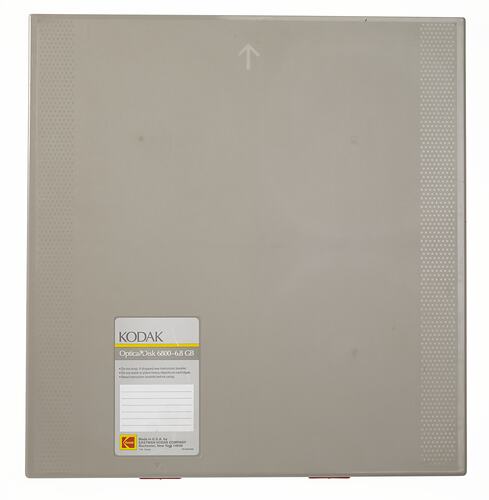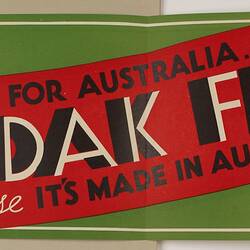Summary
Alternative name: Laser Disc
Optical disk manufactured by Eastman Kodak Company, USA, and used as a test disk by Kodak Australasia Pty Ltd software engineers working in the Advanced Imaging Systems (AIS) group, at Kodak's Coburg factory in the late 1980s. The donor of the disk was the AIS group projects manager who worked with the team from the late 1980s to mid 1990s.
The Eastman Kodak optical disks were designed to store digital data, and represented one of the earliest commercial products for electronic image and document storage, before the era of digital cameras. Sold commercially from about 1988, the Eastman Kodak 14 inch diameter disks were 'write once-read many times' with a 100 year archiving guarantee, and were typically used in automated libraries, with readers colloquially known as 'jukeboxes', which had up to 100 disk capacity. The disks were typically sold to system developers, who had to develop their own software to operate the disks.
This particular optical disk was used to test the formatting of data relating to a document digitisation system that the Kodak Australasia Advanced Imaging Systems group developed in the late 1980s. The Advanced Imaging Systems group was a Kodak Australasia department established in Melbourne in 1988 to develop new business for the company outside traditional product lines. The focus of this group was to find technical solutions to making permanent and accessible electronic copies of legal and archival documents. The group developed software, which was based on a Unix system, for use on commercial hardware systems available from Eastman Kodak and other leading firms, including Eastman Kodak optical disks, scanners and 'jukebox' retrieval systems. Their clients included the Australian Securities Commission at Morwell, and the Land Titles Office in Perth. Their solutions for the digital management of paper documents included digitisation of documents, storage on permanent optical disk media, and fast and efficient electronic retrieval systems. Despite multi-million dollar contracts, developing successful business solutions and expanding from 3 staff to 14, the group ultimately did not fit with the company's future plans and was not continued past the late 1990s.
Physical Description
Grey plastic cartridge housing an optical disk cartridge.
More Information
-
Collection Names
-
Collecting Areas
-
Acquisition Information
Donation from Mr Neil Bucher, Mar 2012
-
Manufacturer
Eastman Kodak Company, Rochester, New York State, United States of America, late 1980s
-
User
Mr Neil Bucher - Kodak (Australasia), Pty Ltd, Coburg, Greater Melbourne, Victoria, Australia, 1985-1995
-
Format
Photograph, Black & White
-
Inscriptions
Printed, sticker, grey ink: 'KODAK / Optical Disk 6800-6.8GB / [extensive text]'
-
Model Name or Number
-
Brand Names
-
Classification
Computing & calculating, Digital computing, Storage & retrieval
-
Category
-
Discipline
-
Type of item
-
Overall Dimensions
420 mm (Width), 440 mm (Height)
Exterior housing measures16.5 inch x 17.5 inch. Optical Disk inside housing measures 14 inch.
-
Keywords




